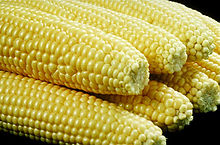Sweet corn
| Sweet corn | |
|---|---|

Husked sweet corn
|
|
| Species | Zea mays convar. saccharata var. rugosa |
| Origin | United States |
| Nutritional value per 100 g (3.5 oz) | |
|---|---|
| Energy | 360 kJ (86 kcal) |
|
19.02 g
|
|
| Sugars | 3.22 g |
| Dietary fiber | 2.7 g |
|
1.18 g
|
|
|
3.2 g
|
|
| Tryptophan | 0.023 g |
| Threonine | 0.129 g |
| Isoleucine | 0.129 g |
| Leucine | 0.348 g |
| Lysine | 0.137 g |
| Methionine | 0.067 g |
| Cystine | 0.026 g |
| Phenylalanine | 0.150 g |
| Tyrosine | 0.123 g |
| Valine | 0.185 g |
| Arginine | 0.131 g |
| Histidine | 0.089 g |
| Alanine | 0.295 g |
| Aspartic acid | 0.244 g |
| Glutamic acid | 0.636 g |
| Glycine | 0.127 g |
| Proline | 0.292 g |
| Serine | 0.153 g |
| Vitamins | |
| Vitamin A equiv. |
(1%)
9 μg |
| Thiamine (B1) |
(17%)
0.200 mg |
| Niacin (B3) |
(11%)
1.700 mg |
| Folate (B9) |
(12%)
46 μg |
| Vitamin C |
(8%)
6.8 mg |
| Minerals | |
| Iron |
(4%)
0.52 mg |
| Magnesium |
(10%)
37 mg |
| Potassium |
(6%)
270 mg |
| Other constituents | |
| Water | 75.96 g |
|
One ear of medium size (6-¾ to 7-½ inches long) maize has 90 grams of seeds
|
|
|
|
| Percentages are roughly approximated using US recommendations for adults. Source: USDA Nutrient Database |
|
Sweet corn (Zea mays convar. saccharata var. rugosa; also called sugar corn and pole corn) is a variety of maize with a high sugar content. Sweet corn is the result of a naturally occurring recessive mutation in the genes which control conversion of sugar to starch inside the endosperm of the corn kernel. Unlike field corn varieties, which are harvested when the kernels are dry and mature (dent stage), sweet corn is picked when immature (milk stage) and prepared and eaten as a vegetable, rather than a grain. Since the process of maturation involves converting sugar to starch, sweet corn stores poorly and must be eaten fresh, canned, or frozen, before the kernels become tough and starchy.
Sweet corn occurs as a spontaneous mutation in field corn and was grown by several Native American tribes. The Iroquois gave the first recorded sweet corn (called 'Papoon') to European settlers in 1779. It soon became a popular food in southern and central regions of the United States.
Open pollinated cultivars of white sweet corn started to become widely available in the United States in the 19th century. Two of the most enduring cultivars, still available today, are 'Country Gentleman' (a Shoepeg corn with small kernels in irregular rows) and 'Stowell's Evergreen'.
Sweet corn production in the 20th century was influenced by the following key developments:
There are currently hundreds of cultivars, with more constantly being developed.
The fruit of the sweet corn plant is the corn kernel, a type of fruit called a caryopsis. The ear is a collection of kernels on the cob. Because corn is a monocot, there is always an even number of rows of kernels. The ear is covered by tightly wrapped leaves called the husk. Silk is the name for the pistillate flowers, which emerge from the husk. The husk and silk are removed by hand, before boiling but not necessarily before roasting, in a process called husking or shucking.
...
Wikipedia
